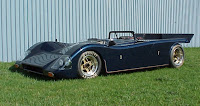 Chevrolet cars have been one of the most well-recognized and well-admired cars for some time now. One of the most well-known lines for Chevrolet is the Chevrolet Vega, a subcompact car which could carry at least four passengers. This was produced by Chevrolet division of General Motors which became their flagship model from 1971 through 1977.
Chevrolet cars have been one of the most well-recognized and well-admired cars for some time now. One of the most well-known lines for Chevrolet is the Chevrolet Vega, a subcompact car which could carry at least four passengers. This was produced by Chevrolet division of General Motors which became their flagship model from 1971 through 1977.This car was introduced as a Vega 2300 in September of 1970 which resonated the star named Vega with a cubic centimeter engine size. It has been said that the Chevrolet, especially the Vega line, is considered to be one of the top selling cars in its earlier years. This is because it has a very sleek and modern design that had a hatchback wagon notch back as well as panel delivery design in its two-door styles.
During the time of the oil embargo, most of the car manufactures geared into manufacturing a more compact concept street rod which served the need to save and minimize the use of fuel / gas. At this time, the General Motors President James Roche announced that they too are producing a new mini or compact car in which case the then Chief engineer Ed Cole alongside with his team conceptualized and developed a compact all-aluminum die cast engine block technology which they called Chevy Vega.
The introduction of the Chevy Vega created a sleeker and technologically driven system to their lines with its notch back style sedan. As the year progressed, there were changes made in the Vega design for more and more additions and upgrades which were being introduced in order to provide for the needs of their clientele as well as to provide a better and smoother driving experience.
However, because of the rush for this street rod introduction and despite the many changes and improvements made, the result was not accepted as warmly as they expected.
Throughout the 70's, the Chevy Vega had undergone quite a few changes and upgrades in order to come up with the very best compact car in the market. These street rods had undergone not only interior changes, engine and power upgrading but at the same time refining the noise and vibration levels which most of the cars during those times were having troubles with.
 In the year 1973, the car underwent at least 300 minor and major changes which included changes in the exterior and interior colors and trims to the bumper, power steering, vinyl interiors or door panels among others. As such every year new changes had been made to make the Chevy Vega adopt to the changes and evolution of how people were living. In the year 1977, the notch back was renamed into a coupe and the changes in the engine which provided for a pulse air system was installed to meet the requirement of the federal government in the standards sets for emission control.
In the year 1973, the car underwent at least 300 minor and major changes which included changes in the exterior and interior colors and trims to the bumper, power steering, vinyl interiors or door panels among others. As such every year new changes had been made to make the Chevy Vega adopt to the changes and evolution of how people were living. In the year 1977, the notch back was renamed into a coupe and the changes in the engine which provided for a pulse air system was installed to meet the requirement of the federal government in the standards sets for emission control.The difference in the Chevy Vega among other street rods out there is that its hatchback coupe had a lower roof line as well as a fold-down rear seat which most of its clientele were excited and happy about. However on the other hand, their sedan line had an enclosed trunk and more rear seat room than the former. While its wagon had a swing-up lift gate with a lower lift cargo height the panel delivery was a one-passenger wagon with an enclosed storage area so that their buyers could have a lot of choices when they decide to drive a Chevrolet.




No comments:
Post a Comment